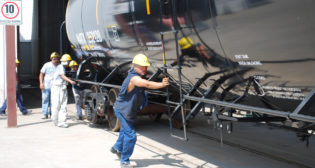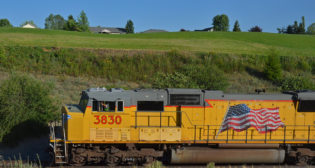
Rail roll and reverse-cant remedies
Written by Carolina Worrell, Senior EditorTTCI is investigating short- and long-term remedies for achieving stable and consistent wheel and rail contact geometry.
The rotation angle, or cant, of a rail relative to the tie is important for providing a stable base to resist rail rollover and wide-gage issues. Tie plates are typically designed to hold rails at an inward 1:40 cant (1.4 degrees) and all references to rail cant angle are relative to this nominal new condition. Rail is considered to have reverse cant if it is rotated toward the field side.
Causes of reverse rail cant include wear at the interfaces between the rail and tie plate, tie plate cutting, tie degradation, and pivoting of the rail out of the tie plate rail seat. These issues are exacerbated by large gage-spreading forces from sources such as friction levels between wheel and rail, contact conditions between wheel and rail profiles, and freight car truck steering.
Transportation Technology Center, Inc. (TTCI) has been working with major North American railroads under the Association of American Railroads’ Strategic Research Initiatives Program to investigate the root causes of rail roll and reverse cant and the remedies for preventing rail rollover derailments.
Forces between the wheel and rail were measured at a revenue service test site constructed with timber ties and cut spikes and a history of reverse rail cant. Five different track maintenance conditions were observed: (1) original condition with reverse rail cant, (2) grinding cycle 1, (3) high-rail gaged with elastic fasteners, (4) low-rail gaged with elastic fasteners and application of top-of-rail friction modifier (TORFM), and (5) grinding cycle 2.
Reverse rail cant caused an improper application of the grinding template in grinding cycle 1, resulting in excessive gage side and insufficient field side metal removal with no reduction in lateral forces. This resulted in vertical loads being applied toward the field side of rail due to poor wheel and rail profile contact, producing low base divided by height values (the ratio of the lateral distance of contact point to rail base field side corner and the height of the rail) that are indicative of a reduced safety margin for rail rollover.
The measured force data indicated that restoring nominal cant and restraining the high rail produced very high lateral forces and significant low rail rotation. Application of TORFM, in combination with restoring the low rail and adjusting track gage, considerably reduced lateral forces even under undesired wheel and rail contact patterns. Rail grinding cycle 2 was more effective in reshaping the rail because the reverse cant had already been corrected, and the slight change in wheel contact location on the high rail resulted in a measurable reduction in lateral forces.
More recently, the static and dynamic rail cants were measured at three different revenue service test sites to investigate how different trains affect dynamic reverse rail cant. The position of the rail in the absence of a train is the static cant and rotation that occurs in the presence of a train is the dynamic cant. The figure shows a time history of the dynamic rail cant at one test site. Examples of train characteristics that were observed to affect dynamic reverse rail cant include long wheelbase three-axle locomotive trucks, freight car truck steering, asymmetrically worn wheels, and train speeds above or below the curve balance speed. These results help railroads better interpret the reverse rail cant values measured by their track geometry cars.
Short-term remedies to address reverse rail cant include rail grinding and consistent TORFM application. Long-term remedies focus on developing strategies for achieving stable and consistent wheel and rail contact geometry through rail profile management, improved rail restraint, improved truck and wheel maintenance methods, and wheel removal limits.



